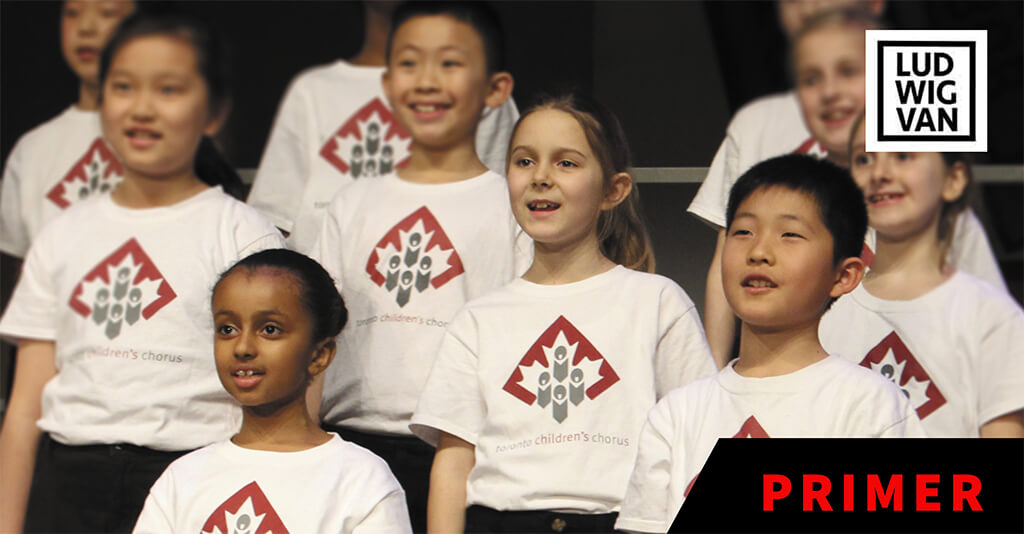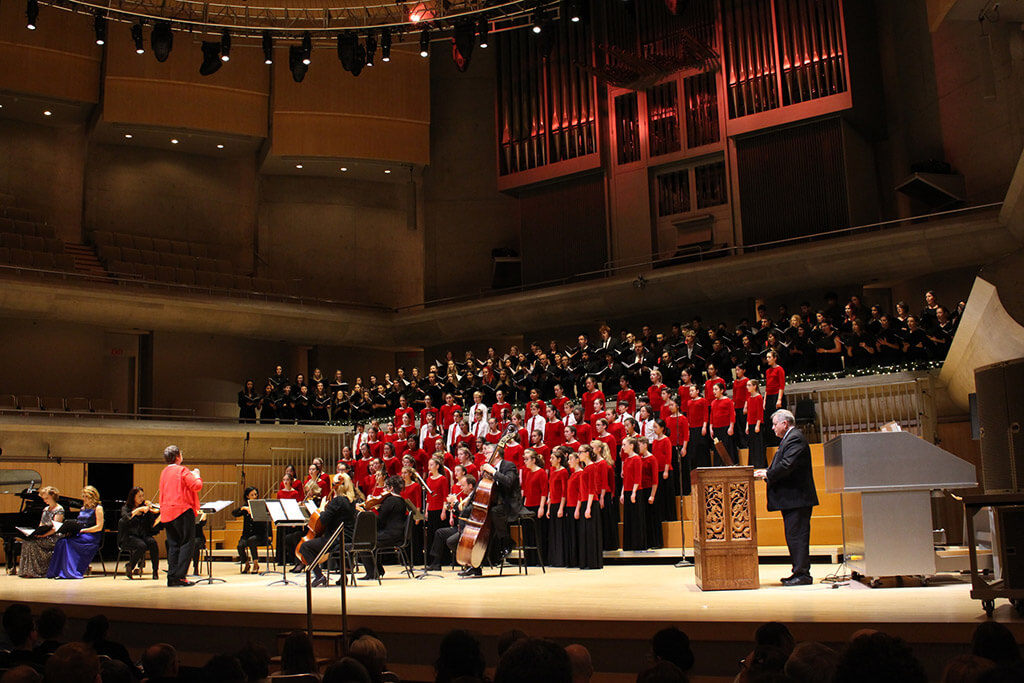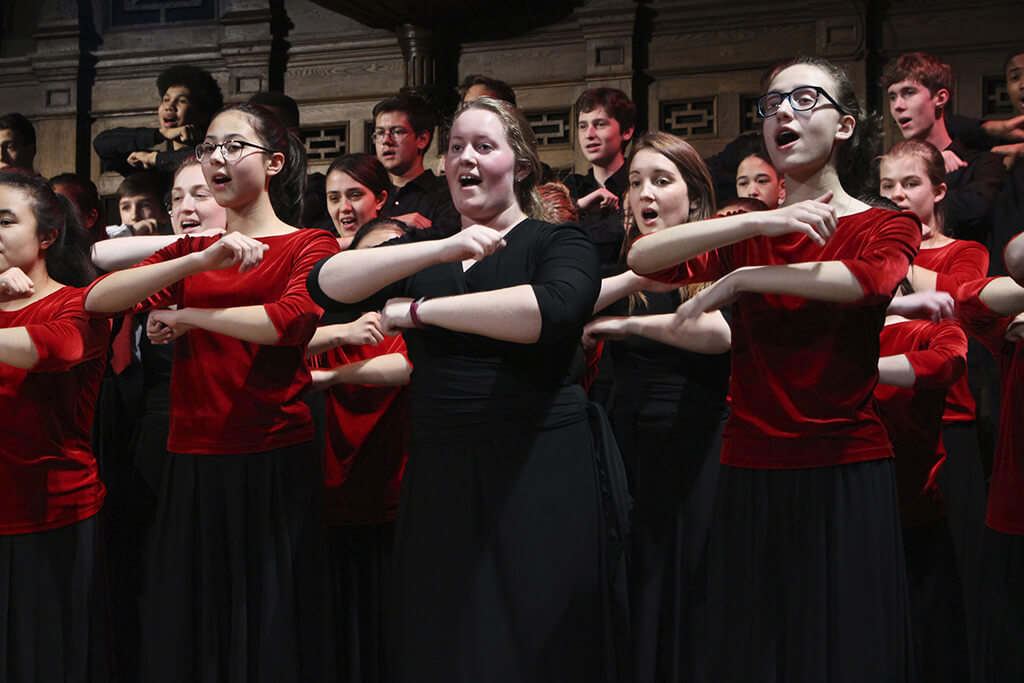
The Toronto Children’s Chorus presents A Chorus Christmas: Children of the World. Featuring 452 singers, nine ensembles, and guests with Artistic Director Elise Bradley. Dec 15, 2pm. Roy Thomson Hall, Toronto. Visit torontochildrenscvhorus.com for ticket information.
Four-hundred-and-fifty-two singers make up the massed might of the Toronto Children’s Chorus (TCC). A small army of children and youth present their annual holiday concert at Roy Thomson Hall. Behind the 452 singers is an army of conductors, parents, staff, volunteers, and chaperones making sure that this concert happens successfully. Artistic Director Elise Bradley is in charge of making sure all the music and artistry happens while Karin Anderson, the Choir Manager is in charge of the behind the scenes. Both chatted with Ludwig Van on the work required to make these concerts successful.
“We’re very organized,” says Bradley. They have to be with so many moving parts. There are nine ensembles that make up the TCC family totalling 452 singers (not including Alumni performers). Nine different conductors will take the stage with five piano accompanists. Joining the ensembles this year are guest musicians Heidi Van Hoesen Gorton (Harp), Michael Bloss (Organ), Neil Deland (Horn), Stan Klebanoff (Trumpet), and Andy Morris (Percussion). And this year, TCC founder Jean Ashworth Bartle is leading the Alumni in the lobby carols.
Leading the organizing of all these components is Karin Anderson, the Choir Manager. The day-of, Anderson is the director, working with the ensembles and Roy Thomson Hall staff to ensure that everything goes as planned. The concert itself is a month’s long process of planning. Artistically, the 26 songs being presented over two hours represent a combined 106 hours of scheduled rehearsal time. Some ensembles rehearse more than others based on their skill levels. Personal practice time, lesson preparation, and artistic preparation add up to even more. A lot of work goes into presenting great music.
Anderson and the artistic team do their best to fit it all into the concert. “We have our running times, I try to factor in applause time, transition time, stage movement time, a buffer just in case,” says Anderson. Even so, every ensemble won’t get a chance to be featured in this concert – there are so many. Last years concert ran almost 3 hours, celebrating the 40th-anniversary of the choir. “Everyone’s coming together to make it more streamlined,” shares Bradley, of the 2018 concert. “This year’s focus is Ceremony of Carols, by Benjamin Britten.”
Sound checks start at 8 a.m. at Roy Thomson Hall, the morning of concert day. Planning these dress rehearsal slots is a challenging process for Anderson. In the concert, the first up are the youngest singers. But they are the last to do their sound check. Making a 5-year-old hit an 8 a.m. sound check and have to stick around till 4 p.m. singing would make for very drowsy, grumpy children.
Anderson takes all of this into account. “When I make plans, I really have to think through not only how dress rehearsal works, but also how it’ll work for the concert. Who is walking in on stage right as someone is going through stage left? Who is moving at what time? The piano moves depending on who’s on stage. It’s closer to the smaller kids, for example.”
There are audience participation carols that everyone enjoys, but also serve a very important stage tool to move hundreds of kids both on and off stage as well as instruments and guest musicians. “It’s like musical chairs,” she says, “trying to get people on and off stage before the music stops.”

Backstage, the most important people are our parent volunteers,” Anderson shares. Bradley similarly intones, “we can’t possibly do this without our parent volunteers.” Anderson relies on these parents for a myriad of tasks. These parents work alongside TCC staff; there are staff Choir Coordinators and a Theory Coordinator in each choir. “Each choir has a parent coordinator and between 5-8 parent chaperones who help supervise and take care of the kids throughout the day and help lead them to the stage,” says Anderson. This is really important, especially for the younger choristers. Parents lead each row of the youngest to the stage. Up in the high balconies where the youngest choirs sit, there are extra parents, seated in the rows to ensure safety and to keep an eye on the well-being of the kids up at such a height.
Roy Thomson is not a small performance hall, but it has a small, backstage area. There are only a handful of washrooms for changing and relief and no single space that can hold everyone before moving on stage. “We don’t fit,” Bradley says “It’s as simple as that, actually. The main choir has to be in the lobby. We squash in and around.” In every space available, there are kids marshalling and waiting to take the stage. TCC has to rent keyboards for each ensemble so that they have an instrument to practice and prepare in places that don’t normally have keyboards,
Each choir and its chaperones have to figure out washroom breaks for their kids, “which does get quite complicated as everyone is free around the same time during breaks,” shares Anderson. “The parent chaperones are really important. Some kids don’t feel well or have spilled something on their shirts.” Just in case, each choir has its own uniform bag, “hairpins, elastics, extra shirts, extra black socks, black pants and black shoes. Things happen of course, and you have to be prepared.”
“The most important thing, and something I really look out for, is looking at the kids when they’re singing. Under the lights, the kids might start to get faint, or woozy. It’s not uncommon as a young chorister to faint. At that age, they don’t know what’s happening to their body when they’re about to pass out. It’s very scary. They don’t want to mess it up; don’t want to attract attention. I think people forget how much effort it takes to sing. It’s a full body athletic experience.” All the parents and staff around make sure the kids are well-tended. Part of the rehearsal process is having the singers take the stage, look around, see the size of the hall and be disciplined enough to perform. But, this is Roy Thomson Hall, after all, the largest symphony hall they’ll probably ever perform in; even adults get intimidated.
“Once the day actually comes, that’s the fun part. When the plans are in place, you follow your plan. The lead up to it is the busiest time. It’s all very exciting. To sing in that kind of space and to bring in holiday cheer,” says Anderson. “The concert days are my favourite part of my role at the TCC. It’s one of the things that remind us why we do what we do. Especially the young ones, I get to see their faces when they’re about to walk on the stage of Roy Thomson Hall; it’s such a special thing.”

By the end of the planning, Karin will have a schedule provided to the kids and their families, one for the artistic team, one for the conductor assistants, and one master memo that goes to everyone in the organization that summarizes, what they need to wear, what times to arrive, and how to get their kids after.
It is a whole other logistical moment as all the kids on stage need to get to their parents without getting lost. “We have the choirs on the stage and in the loft. All the training choirs, the youngest singers, are at the very top. Before the concert, they carry up all their stuff and tuck it under the seats. So when they take their spot for the concert, all their stuff is already there.” For dozens of kids who have parents attending, everyone trying to find one another in the lobby would be chaotic. For the training choirs, the parents will pick up their kids at the upper balconies themselves; rather than having the rush of kids, parents, and audience into the lobby at once.
The two hours will go quickly for these singers. These concerts are a reminder that great music education requires great performance opportunities. The learning experience of performing at Roy Thomson Hall is unlike any other. TCC is an educational endeavour that reaches far beyond the classroom.
Bradley is quite clear that the work is so much more than music. It’s about making sure that these children have all the tools they need to be great adults. “The kids are turning into great human beings, because that’s the other thing that we do, try to bring about goodness and care. And show that through discipline and hard work and love and honesty and integrity, we are better human beings.”
“We are cognizant of more than just coming in a room and singing,” Bradley says, “but we also want people to come and see the concert.”



